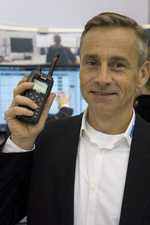|
“Secondly, this radio is IP67 classified, so basically you can take it under water, one metre down, and leave it there for about five minutes. I wouldn’t be very worried if you left it there for, let’s say, an hour, and it would probably still work. So it really is completely waterproof, and it has the highest IP classification of any handheld TETRA radio in the market today – including ATEX radios.” Furthermore, he went on, in the STP9000 Sepura has introduced a choice of three contrasting user interfaces. While the company had remained true to the traditional PMR user interface with a ‘flat’ menu structure, devices such as PDAs and smartphones had now familiarized users with more complex menu structures where they would expect to dig deep to find some of the functions they needed. By altering the installation options, the user can choose from three user interfaces, including a familiar mobile phone-like configuration. “Not only are we offering this choice but we let the administrator of the fleet decide whether they choose what interface to give the individual user, or whether the user can choose by himself”, Mr Barfoed said. “The important thing here is that, irrespective of what user interface is chosen, the functionality stays exactly the same. And the way the radio operates in the network, which is something which is very much key for any operator of a secure network, it doesn’t change its behaviour, it doesn’t change what capacity load it places on the network.” More ATEXAnother new TETRA terminal announced by the company was a full keypad version of its intrinsically-safe handheld radio, supplementing the simplified keypad version which has been available since March. “We are getting very close to having shipped about 10 000 of these things”, commented Mr Barfoed. “These radios are certified to the very latest ATEX standard, which is called Version 6 of the ATEX standard. And there’s not another product that is certified to that – which, incidentally, includes any accessory that we put on to the radio. It needs to be certified with the radio, so when you walk into these hazardous environments, you can be sure that everything you’ve got is certified – which wasn’t required before. “It’s going to mean an additional investment for customers because everything has to be certified and everything has to be ATEX, but it does add security and it does have implications regarding insurance.” Also featured on the stand was STProtect, an indoor location product developed by Sepura for lone workers. Designed for use in environments such as prisons or mines where GPS location is not available, it relies on compact radio beacons installed at key points. Coverage range of the beacons can be adjusted from 10-20 metres down to very short distances, to deliver the required positioning accuracy. The system supports defined routes and checkpoints for security guards, access control for gates and doors, and man-down features.
(中国集群通信网 | 责任编辑:陈晓亮) |

 Latest
Latest